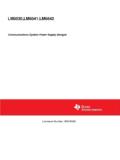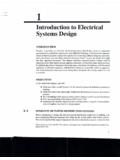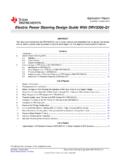Transcription of Eliminating harmonics from the facility power …
1 power system anomalies that peri-odically occur in a facility s elec - trical system can cause equipmentmalfunction, data distortion, transformerand motor insulation failure, overheatingof neutral buses, nusiance tripping of cir-cuit breakers, and solid-state componentbreakdown. The cost of power qualityproblems can be enormous. Equipmentreplacement can cost tens of thousandsof dollars. Downtime, however, can runin the millions of dollars. power quality problems take manyforms. Voltage sags, transients, and spikesare probably the most understood of theseforms.
2 Harmonic distortion, though, canoccur from adjustable-frequency drivesand other non-sinusoidal loads typicallywhere ac/dc conversion is present. In any facility , the voltage supplied by apower system is generally not a pure sinewave. Rather, it usually possesses someamount of distortion, which has a funda-mental frequency and harmonics at thatfrequency, (see box, Harmonic basics ). Distortion comes from various sources,particularly equipment with power -cir-cuitry devices that draw current in a non-linear fashion. Non-linear devices arethose that switch the current onand off,such as transistors, diode bridges, andSCRs.
3 Two major classes of equipmentthat contain these devices and producecurrent harmonics are: Internal power supplies, such as com-puters, copiers, and electronic ballasts. Any type of static power converter,such as an uninterruptiblepower supply, dc drives, oradjustable-frequency con-trollers (AFC). An AFC has a convertersection, which converts acline power to dc, and aninverter section, whichconverts dc to adjustablefrequency ac. Both con-tain non-linear devices intheir power circuitry, andtherefore produce har-monics on the input andoutput lines.
4 Input line harmonics are caused solelyby the converter section and are usuallyreferred to as line-side harmonics . Out-put line harmonics are caused solely bythe inverter section and are called load-side harmonics . They are completely iso-lated from each other. Thus, load-sideharmonics only affect the equipmentdriven by the AFC, while line-side har-monics affect the whole power system . Standard three-phase PWM drives typi-cally use a six-diode rectifier bridge in theconverter section, Figure 1. These diodesdraw current non-linearly, in a 6-step con-verter waveform, Figure 2.
5 The high lev-els (amplitude) of 5th and 7th harmonicsEliminating harmonics from the facility power systemAdjustable-frequency drives and other devices can produce harmonics on a facility s power system . These harmonics can corrupt data, damage equipment (usually by excess heat), and cause erraticequipment performance. But these effects can be controlled by monitoring and analyzing the wholesystem, determining safe harmonic levels, and choosing the right attentuation solution. KEVIN J. TORY and RICH POPE, Cutler-Hammer, Eaton TRANSMISSION DESIGNAPRIL 199743mPRODUCT FOCUS: ADJUSTABLE-SPEED DRIVESK evin J.
6 Toryis application engineeringmanager, Solid State Motor Controls, Cutler-Hammer, and Rich Popeis product man-ager, power Distribution Components Div.,Cutler-Hammer, Eaton Corp., Pittsburgh. Figure 1 Six-diode rectifier bridge inthe converter section of a standard three-phase PWM drive. A B CDC+DC-and the magnitude of each decreases asharmonic number increases. Harmonicsabove the 25th generally have little effectand are usually considered insignificant. In this waveform, only certain har-monic orders are present: 5th, 7th, 11th,13th, 17th, 19th, 21st, and 25th.
7 To deter-mine the number of harmonic orders in awave for a six-diode bridge, solve for: h = 6k 1, where kis an integer. Almost any three-phase system willpossess a degree of line unbalance, pro-ducing 3rd harmonics . In a balancedthree-phase system , however, these har-monics are in phase with each other andtheir effect is typically small. Load-side harmonic effectsAs mentioned earlier, load-side har-monics are generated by the inverter sec-tion of an AFC and may effect the motorand connecting cables. AFCs can de-crease motor life because of the addi-tional heating caused by the harmonics (see PTD, Solutions to motor insulationfailures, 8/95, p.)
8 43). High-efficiencymotors with a service factor of canhelp compensate for deleterious effects. Line-sideharmonic effectsUnlike load-sideharmonics, line-sideharmonics effect thewhole power distri-bution system . Har-monic currentsdrawn from thesource give rise toharmonic voltagesthat affect otherequipment on thedistribution much thesevoltages effect thesystem depends on system load and im-pedance. Equipment considered sensi-tive to harmonics includes communica-tion equipment, computers and compu-ter systems, diagnostic equipment,switchgear and relays, transformers, andstandby equipment, comput-ers, and diagnostic equipment are de-signed for operation on smooth sinu-soidal input.
9 Therefore, harmonics cancorrupt data or result in false commands. Transformers may experience extraheating in the core and windings. Tocombat potential problems, many trans-former manufacturers rate their prod-ucts with a K-factor. This factor indicatesthe transformer s ability to withstanddegradation from harmonic manufacturers simply derate theirtransformers to compensate for potentialproblems. Others incorporate specialfeatures to better handle harmonic cur- power TRANSMISSION DESIGNAPRIL 199744mPRODUCT FOCUS: ADJUSTABLE-SPEED DRIVESI5 = = = = = = = = 2 A 6-step converter waveform.
10 Harmonic basicsHarmonic currents and voltages are usuallymultiple sinusoidal waveforms that combine toform distorted waveforms. Figure A and FigureB waveforms are both pure sine waves, free ofdistortion, and differing only in frequency andamplitude. Figure B has five times thefrequency and one-fifth the amplitude of FigureA. The wave in Figure A is called thefundamental. The wave in Figure B is aharmonic of the wave in Figure A because itsfrequency is an integral multiple of it. Becausethe harmonic has a frequency five times that ofthe fundamental, it is called the 5th harmonicor 5th order harmonic.















